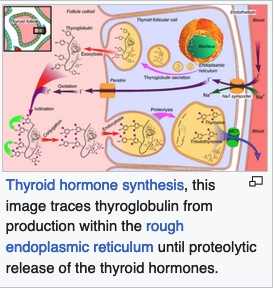The attached image comes from Wiki (I'll attach it to a reply so it can be bigger on your screen):
en.wikipedia.org/wiki/Thyro...
It is used in the Wiki article on Thyroglobulin:
en.wikipedia.org/wiki/Thyro...
We all come at these things from different directions, but to me, this is one of the best illustrations available.
In summary:
The thyroid cells take up the ingredients from the bloodstream.
The thyroid cells make thyroglobulin and push both the thyroglobulin and the ingredients into the colloid in the follicle - the inside of the balloon!
The thyroid hormone is actually made in the follicle at the ends of the thyroglobulin. Thyroglobulin is like a little machine tool which can make T4 and T3.
Then the thyroglobulin - with thyroid hormones still attached - gets taken back into the thyroid cell. And the thyroid hormone is split from the thyroglobulin and transported into the bloodstream.


